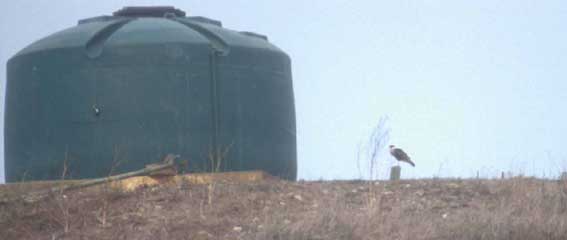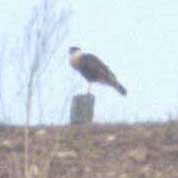11-13 Aug 2002
Armstrong Ranch, N of Marina
photo © Bill Hill
This is an expanded commentary from the Monterey County highlights of 2002, discussing the Crested Caracaras that appeared in Monterey County in August, and in adjacent Santa Cruz County in September. The abbreviations "MTY" and "SCZ" mean "Monterey County" and "Santa Cruz County," respectively, in the text below. Text by Don Roberson. Photos on this page are copyrighted by the photographers to whom they are attributed, and may not be reproduced in any form (including other web sites) without the express consent of the photographer.
Crested
Caracara Caracara cheriway
11-13 Aug 2002
Armstrong Ranch, N of Marina
photo © Bill Hill
Surely the most interesting bird of the summer and early fall was this Crested Caracara present for 3 days along Lapis Road and Del Monte Ave., just north of Marina. The bird could be very obliging (as suggested by Bill Hill's superb photo) or very elusive. [The author of this web page was in Africa at the time, but can confirm that the caracara was "exceptionally elusive" over many hours 16-20 August.]
The bird was clearly in molt. Note the very worn and buffy-brown feathers of the lower lesser coverts, median coverts, tertials, and scapulars, and how they contrast with the fresh, black feather coming in on the scapulars, upper lesser coverts. The bird is clearly in wing molt: the three tertials are worn and brown but the innermost secondary is fresh and black, contrasting with the next one that is worn and brown. The back in a mixture of old and new feathers, as is the crown. I am confused about the plumage state, however. Several Internet postings state that this is the molt from Basic I to Definitive Basic (=adult) plumage ? and that may be true ? but the worn brown coverts, scapulars, and remiges appear to me to be worn juvenal feathers (see photos in Wheeler & Clark 1995). If so, Basic I is acquired by partial molt and has many retained juvenal feathers. It is those feathers that are now being replaced through a complete molt. More research is needed, but in any event this is a rather young bird, no more than a year to a year-and-a-quarter old at a maximum. Its age is of importance in evaluating whether it is a wild vagrant or a likely escape (see below).
On 21 September, a Crested Caracara was found along Swanton Rd., just north of Davenport, in adjacent Santa Cruz County. It is still present as of this writing [26 Sep]. I am posting here (below) a couple distant photos I took yesterday [25 Sep] in hopes of addressing the "is it the same bird" question.

I studied this bird, along with Janet & Art Cupples, in a 20-60X Leica scope, and drew a sketch. We also had reference to a black-and-white copy of Bill Hill's photo. My field notes on differences between the SCZ bird and the MTY photo read:
"During my scope view, I mostly focused on details of the crown, back, and upperwing coverts to compare the current state of plumage to photos of the MTY bird from about six weeks ago. The MTY bird had a brownish cap/crest with many black feathers recently molted in; this SCZ bird appeared to have an entirely black cap/crest. ... The MTY bird had mostly worn, brownish scapulars, tertials, and upperwing coverts, and a speckled black-and-brown back.... This SCZ bird seemed to have an entirely black back and black scapulars (at least as much as I could see from the side view of the bird's left side), and at least two innermost tertials were new, black feathers. But the outer tertials, and much of the upperwing coverts, were composed of quite worn, brownish feathers. .. New black feathers were appearing on the upperwing coverts. These appeared to be many of the outermost lesser coverts and probably new bottom row of lessers and median coverts were just starting to appear, thus forming the two black lines in the lower part of the wings. I did not see the bird in flight, but photos I have seen of this bird, and from details reported by others, I understand that it is in active primary molt and (possibly) tail molt at this time."
|
|
 |
I have no experience with molt sequences in Crested Caracara. I did
notice that several Turkey Vultures seen were in
active flight feather molt. I also don't know how long it takes to
molt in various feathers, but the differences that I noted between the
MTY bird reviewed in photos, and this bird studied in the field, seemed
consistent to me with what body molt might have been completed within 6
weeks. Given this, I currently think it is very likely the same bird that
was in MTY in August.
Art & Janet Cupples personally saw a bird at Pt. Mugu, Ventura County, earlier this year (in August). We discussed this SCZ bird extensively on these plumage details. They both state that the Pt. Mugu bird looked more like a full adult than does this bird still in molt from (apparently) Basic I to Definitive Basic. Accordingly, the VEN bird must have been a different bird. I have not yet seen details or photos of a Santa Barbara Co. bird in July 2002, so as yet have no opinion as to whether it is a different bird than this MTY/SCZ individual.
I have always believed that two historical records of Crested Caracara
from Monterey Bay, cited by Grinnell & Miller (1944), were escaped
mascots or pets from whaling ships. There were at Monterey between 18 Oct-14
Nov 1837, and at Seal Rocks, Pebble Beach, in Feb 1916 (said to have been
photographed; I haven't been able to locate the photos).
Whaling was extensive in Monterey Bay in the 19th century, and active
shore-based whaling stations were in operation from 1854-1905 and again
1919-1925. Gray Whale whaling continued until banned in 1937 (Gordon &
Baldridge 1991). Thus the 1837 and 1916 birds occurred during the times
when whaling was very active here, even if slightly outside the actual
dates of shore-based whaling stations. Whaling ships would have routinely
docked at Monterey for provisions. Given the scavenging habits of caracaras,
and its abundance on coastal beaches in Mexico and southward, I think it
very likely to have been kept as a mascot on a whaling ship. It should
have been easy enough to feed it blubber or other scraps.
With whaling now concluded in Monterey Bay, the only source of escapes are (a) falconers or private aviculturalists or (b) zoos. Those to whom I've spoken about falconry or private holdings believe it very unlikely to be kept much in private hands. Some are certainly kept in zoos. When I lived in Berkeley & Alameda, I often saw the adult in a small cage at Lake Merritt, Oakland. I have seen a few in other zoos; all were adults. A known zoo escape was seen at various spots in Virginia and North Carolina some years ago (Potter et al. 1980). I would expect most zoo birds to be banded. The fact that this bird is no more than a year and a few months old make it a very unlikely candidate to be a zoo escape. I am unaware of any captive breeding of this species.
In contrast, Crested Caracara is showing significant range expansion
and increasing numbers in central Texas (Matt White, in litt., after
he posted similar comments on a chat line). There are a growing number
of records from well north of the species' range in North America, mostly
from summer, including birds to British Columbia (May-June 1998; Plath
1998), Minnesota (July 1994), and Ontario. Alan Wormington supplied the
following information from Wormington (2002) on
the three July records from Ontario:
(1) July 18, 1892: one adult female, Victoria Island, Thunder Bay (George Cosgrove) - specimen now missing. References: Atkinson (1894); Wormington (1986).Given the information currently available -- the young age of the bird, the records from s. California in May & July, range expansion in Texas, extralimital records far to the north in summer -- I believe that the evidence better supports the idea that the MTY/SCZ caracara is a wild vagrant rather than an escape from captivity. I have provisionally treated it as such in the soon-to-be published Roberson (2002; release date mid-November).
Notes: The following is a direct quote from Atkinson (1894): "On July 17, 1892, a strong south-west gale struck the shore of Lake Superior, and the islands in the vicinity of Thunder Bay, district of Algoma; it
blew all day, and on the following morning Mr. George Cosgrove, lighthouse keeper on Victoria Island, about thirty miles south-west of Port Arthur, picked up a bird which had struck the light during the storm."(2) July 6, 1994: one, Pelee Island, Essex (David A. Kraus, Gerald Waldron, J. Peter Chapman). Reference: Pittaway (1995).
Notes: Another Crested Caracara was recorded in southeast Minnesota on July 18, 1994; this is only 12 days after the Ontario occurrence.(3) July 16-26, 2002: one, Fort Albany, Cochrane (Ivan Edwards et al); record currently under review by the OBRC.
I thank Janet & Art Cupples, Joe Morlan, and Robbie Fischer for cell-phone calls that helped me see the SCZ bird. I thank Alan Wormington and Matt White for email comments on the status of caracaras in their home patch, and Bill Hill for graciously permitting the republication of his superb photo.
Joe Morlan has additional information about the SCZ bird, and about other recent California observations, on his new caracara page.
Literature cited:
Atkinson, G.E. 1894. Polyborus cheriway on Lake Superior. Biological Review of Ontario 1: 9-10.TOPGordon, D.G., and A. Baldridge. 1991. Gray Whales. Monterey Bay Aquarium, Monterey CA.
Grinnell, J., and A.H. Miller. 1944. Distribution of the Birds of California. Pacific Coast Avifauna 27.
Pittaway, R. 1995. Ontario Bird Records Committee Report for 1994. Ontario Birds 13: 46-65.
Plath, T. 1998. A Crested Caracara at Drury Inlet, British Columbia. Birders Journal 7: 215-216.
Potter, E.F., J.F. Parnell, and R.P. Teulings. 1980. Birds of the Carolinas. Univ. of North Carolina Press, Chapel Hill, N.C.
Roberson, D. 1985. Monterey Birds. Monterey Pen. Audubon Soc., Carmel, CA.
Roberson, D. 2002. Monterey Birds. 2nd ed. Monterey Pen. Audubon Soc., Carmel, CA.
Wheeler, B. K., and W. S. Clark. 1995. A Photographic Guide to North American Raptors. Academic Press, New York.
Wormington, A. 1986. Ontario Bird Records Committee Report for 1985. Ontario Birds 4: 3-18.
Wormington, A. 2002. The Rare Birds of Ontario: A Catalogue of Distributional Records. Unpublished Manuscript.
Page created 26 Sep 2002